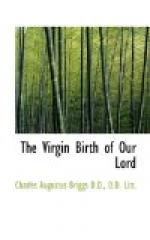II
THE GOSPELS OF ST. MATTHEW AND ST. LUKE
But if such was the belief of Christians everywhere in the early years of the second century, can we trace the evidence further back? In answering this question, we are brought face to face with the Gospels. But first it must be noted that the positive evidence for such a subject must, in the nature of the case, be much more limited than the evidence for the Resurrection. The Apostles were primarily witnesses of what they themselves had seen. There are two persons, and two only, from whom we could reasonably expect to hear the truth about the mystery of the miraculous Conception—Mary and Joseph; and when we open the Gospels we have, as everybody knows, two narratives of the Nativity—St. Luke’s and St. Matthew’s.
(I) St. Luke, in describing the Nativity, is using an Aramaic document. There is a great difference in style between the preface, which is his own, and that of the narrative which follows. It was an Aramaic document (as Godet, Weiss, and Dr. Sanday agree); but more than this, as Bishop Gore has pointed out: “It breathes the spirit of the Messianic hope, before it had received the rude and crushing blow involved in the rejection of the Messiah."* The Christology of the passage is pre-Christian: “He shall be great, and shall be called the Son of the Highest: and the Lord God shall give unto Him the throne of His father David: and He shall reign over the house of Jacob for ever; and of His kingdom there shall be no end."+
— * Gore, Dissertations, p. 16. + St. Luke i. 32, 33. — “How can all this,” Dr. Chase asks, “be the invention of a believer in the Messiahship of Jesus when the Jews had rejected Him, and when the Resurrection and Ascension had raised the conception of His Messiahship to the height of a spiritual and universal sovereignty? The Christology of these passages is a striking proof of their primitive character."# It is indeed difficult to see how men can read the Benedictus or Magnificat without realizing this. Every verse in them is full of Jewish thought and Jewish expressions, such as would have been impossible had they been the inventions of a later date.
— # Chase, Supernatural Elements in our Lord’s Earthly Life. —
That is to say, these two chapters bear traces on the face of them of being what they profess to be—a true and genuine account of the human Birth of Jesus Christ, received ultimately from her who alone could be competent to give it—the Virgin-Mother herself. For it must be Mary’s account if it is genuine. It is given to us by St. Luke, who tells us that he “had traced the course of all things accurately from the first,” and who had gathered information concerning, be it observed, “those things which are most surely believed among the disciples."* “It is an account,” says Bishop Gore, “which there is no evidence to show the imagination of an early Christian capable




